Last summer the bagel-making project went off the boil when the spring term ended and, with it, access to my hungriest taste tasters. Without them, I was making a dozen bagels a week mostly for myself, and that’s just a bit more than I can consume. And without school, I had increased parenting responsibilities and no fewer work responsibilities. I didn’t always have the time to make the bagels; if I did have the time, I often lacked the energy. So I set the bagels aside for the summer and figured I’d get back to them when school resumed in the fall.
When school started I was still pretty busy, and I just never got bagels back into my schedule again. (I was baking challah every week, and modifying those recipes like crazy, but we can talk about that later.)
But today I had time, so I’m back in the bagel game. I’ve also figured out a way to carve out a bit extra baking time, even during the hectic youth basketball season. Let’s get back to the bagels.
January 15, 2017
I can’t find the notebook I used last year to draft my bagel related blog posts and document my recipes and their variations. Normally this would stop me in my tracks, and I would spend so much time tearing the house apart in search of the notebook that I wouldn’t have enough time to make any bagels. So I’m writing this on a loose sheet of copy paper for now. If I find the notebook WHEN I find the notebook I will insert it at the appropriate place.
I paid a quick visit to a local, independent bookstore just before New Year’s Eve, and I almost walked out with a volume of the best food writing of 2016. Then I saw Yiddish Cuisine: Authentic and Delicious Jewish Recipes by Florence Kahn, and I asked myself, Do you want to read food writing or learn to make bagels? Kahn’s book did include a bagel recipe, so the food writing book stayed on the shelf to tempt another reader.

The photography in this book was one of the biggest draws for me, and the story really focused on the history of the area in Paris where the author has her Yiddish restaurant. Yes, a Yiddish restaurant in Paris. Just the thought of it made me smile, and I hope to return to Paris and visit it some day. Until then, I have some really interesting recipes to try, including “Matzagna” and some savory cheesecakes. The “breads” chapter is slim — just bagels, blinis, and pletzels even though baguettes and challah are pictured inside and outside the book, which is a bit misleading — but since I would like to try making all of these things I did not count that as a drawback.
However, when the book popped up as one of my Amazon.com recommendations, I decided to take a look at the reviews. There was only one, and it was negative. It may seem unfair that someone who didn’t make any of the recipes gave the cookbook a negative review, but I think his rating reflects his disappointment in the fact that, after he had the book, he took a closer look and realized that the recipes themselves just didn’t appeal to him. And I think that’s a fair reason for a low rating: he felt that the book promised him more than it delivered. I certainly like the book for than the reviewer did, but I have my own issues with it. If I end up writing my own review, it will be on the basis of the recipes I’ve tried; at this point I cannot think of the book as a disappointment.
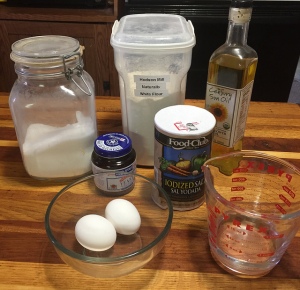
The recipe
Kahn’s bagel recipe listed only seven ingredients, including water, and at first glance it looked very simple. The more time I spent reading and re-reading it, though, the more I realized that it might present some serious challenges for me to make.
Process: Kahn uses a food processor, which means that for this recipe the only procedure is to put all the ingredients (except the yeast) into one, later adding the yeast as well. I do have a lot of devices and appliances in my kitchen, but one item I have never owned is a food processor. I just don’t think it’s a worthwhile investment for me, as I rarely use recipes that call for one. So right away, I knew I would have to look at all the ingredients in the list and figure out how to combine them in a more traditional way.
Yeast: The type of yeast Kahn uses is baker’s yeast, which is a moist cake rather than the packets of dried yeast I am accustomed to using. I have seen baker’s yeast available at one or two of the grocery stores at which I shop, but it’s certainly not at the closest ones. The change of yeast type entailed another change of procedure: I would have to add more water to the recipe. But how much more?
Flour: The recipe states to use “7 cups of flour.” Well, what kind of flour? There are myriad options, and some clarification would have been appreciated. But a little deductive thinking led me to believe that if she had meant whole wheat flour, whole wheat pastry flour, bread flour, rye flour, or anything other than good ol’ all-purpose flour, she would have said so. All-purposed unbleached it would be, and I was fortunate to have about 7.25 cups ready from a single brand.
I had other, minor, concerns about the ingredients list. One of the items was sunflower oil. I actually had a bottle of sunflower oil already, but I purchased it about 3 years ago and was not sure of its usability. On the other hand, she must have called for sunflower oil for a reason, so I used it. Another change I made was for the egg wash. The recipe makes 10 bagels, and the suggested wash was two whole eggs. That seemed like a rather extreme amount of cholesterol to apply to such a small batch of carbohydrates. Instead, I used about one egg’s worth of egg white, as I have been doing for my challah.
The recipe also had a major difference from almost all of the bagel recipes I baked last year: the dough had neither a rising time or a boiling time. Apparently I was just supposed to throw everything into the food processor, take the dough out, form bagels, and bake them. It seemed like a strange way to make yeasted bread, but there was no reason not to follow the instructions (well, my modified ones) and see what happened.
The process
Because of the change in the yeast, the process was changed from the start. I began by warming a half cup of filtered water, and adding the yeast and a small amount of the sugar to make a little slurry and activate the yeast.
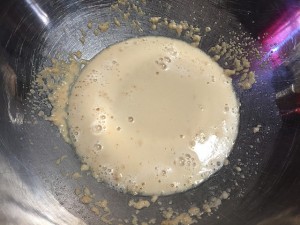
After letting it get a five-minute or so head start, I added the liquid ingredients — the sunflower oil and the eggs. Meanwhile, the oven was preheating to 375°F.
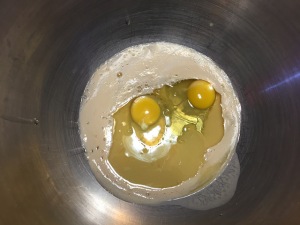
Next I added the dry ingredients, which I had already measured out. Salt, the rest of the sugar, and the flour, one cup at a time.
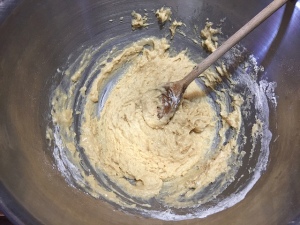
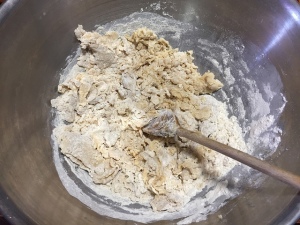

The mixture was definitely too dry to come together as a dough, so I started warming water and adding it to the dough in half-cup batches. After the third addition of water, the dough was finally workable. In fact, it was quite a bit sticky and I needed to add a dusting of flour to get everything to come out even. So I wound up using two cups of water in a recipe that had originally called for 2-1/2 tablespoons.

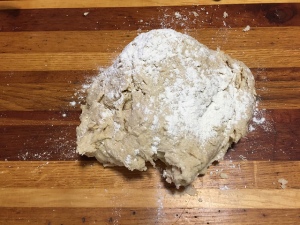
I kneaded the dough for a minute or two, but didn’t want to overwork it. I divided the dough into twelve portions, as equally as possible, then started forming bagels.

Before preheating the oven, I had moved the racks so that I would be able to put in two cookie sheets at a time. Because I was concerned about the lack of rising time, however, I decided to bake the bagels in two batches of six, letting the second batch rise during the 22 minutes the first batch was in the oven.

I also decided to focus on the bagels themselves and not worry about adding toppings. I had made plenty of changes already — perhaps too many — and wanted to focus on the taste and texture without being distracted by other qualities.
The first batch came out rather pale overall, with only a few browned spots. They had the strained, textured look of some other bagels I had made last year, but they seemed to be cooked through.
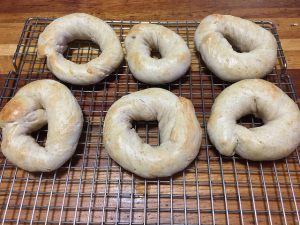
By that time, the second batch had rested and puffed up a bit, filling out in a way the first batch wasn’t able to do. After baking for the same 22 minutes, they looked just as pale as the first batch when I took them out of the oven. I think you can see for yourself that they were more handsome.

Results
When the first batch came out, my family testers all said, “I want a bagel! I’m glad you made bagels!” In the end, nobody chose a bagel from the first batch — the second batch just looked so much better.
Bagels from each batch sliced easily with the use of the bagel guillotine, but the difference in internal structure was easy to see. First-batch bagels contained streaks of what looked like (but probably was not) uncooked dough.

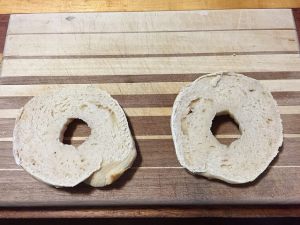
The bagels were eaten plain, toasted with butter, toasted with cream cheese, and toasted with honey. The taste was fine, but nothing special. However, I have changed the recipe so much that it can’t be judged on its own terms. I may have to use the baker’s yeast in order to bring the recipe back closer to its origins, and maybe that will also allay my concerns about the lack of rising time for the dough.
The recipe is definitely not a traditional bagel recipe, and it wasn’t written for beginning home cooks. Instructions are unclear, confusing, and even contradictory; there is absolutely no attention given to substitutions or answering any questions a home baker might have. You’re pretty much on your own as to how you are supposed to travel from the ingredient list to the beautiful photos of finished bagels. But really, I don’t think the author wrote the book to hold my hand. I think Kahn is proud of her restaurant and is showing it off, and she’s sharing a few (but definitely not all) of the recipes her customers most enjoy. I can’t find fault with her motives for writing the kind of book that she did. I reserve the right to change my mind if I never manage to make a bagel like the one in the pictures, but never is a long time. For now, I’ll keep plugging away at it.
